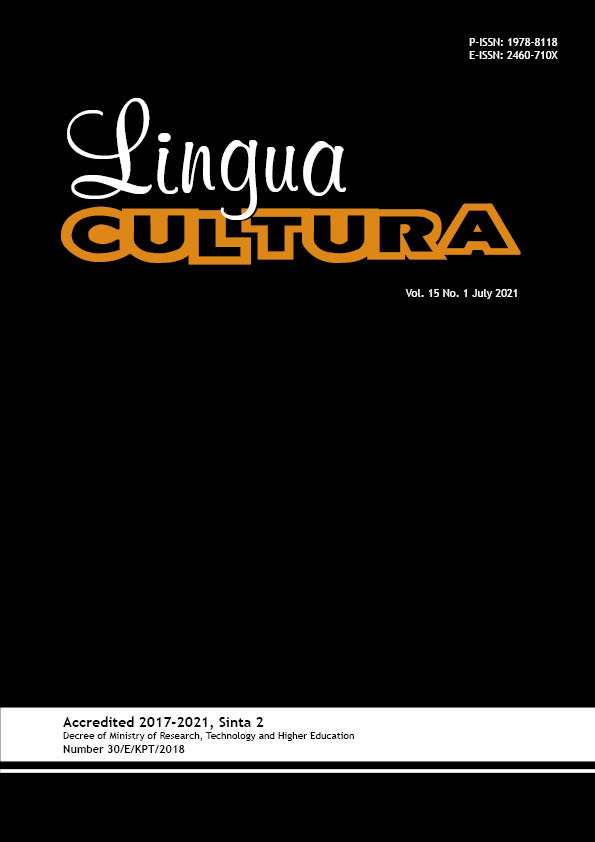Symbols of Heroes in the Indonesian and Chinese Movies
DOI:
https://doi.org/10.21512/lc.v15i1.6969Keywords:
Indonesia movie, Chinese movie, heroic symbol, comparative literatureAbstract
The research aimed to compare a movie with the theme of heroes from Indonesia and China concerning message related to heroes, hero images, ideology, and even heroic culture of the two countries. It explored 20 Indonesian and Chinese films with comparative literary perspectives related to the theme of heroism. The focuses of the research were (1) how could the image of the hero created by the film provide a view of each country’s people’s culture, (2) could the movies provided more detailed information on the policies of each country, and (3) how could films strengthen the relationship between Indonesia and China. The research applied a qualitative methods with a comparative literature perspective. The data source were from the dialogues in the film “Merah Putihâ€, “Gieâ€, “Susi Susantiâ€, “Soekarnoâ€, “Tanah Surga Katanyaâ€, “3 Srikandiâ€, “Laskar Pemimpiâ€, “Guru Bangsaâ€, “Soegijaâ€, “Jenderal Soedirmanâ€, 攀登者 (The Climbers), ä¸å›½æœºé•¿ (The Captain), 红海行动 (Operation Red Sea), 烈ç«è‹±é›„ (The Bravest),战狼 1 (Wolf Warrior 1), 战狼 2 (Wolf Warrior 2), 建国大业 (The Founding of A Republic), 建党大业 (Beginning of The Great Revival), 建军大业 (The Founding of An Army), and å¶é—® (IP Man). Data analysis technique were conducted by (1) determining variables, (2) classification, (3) analysis, and (4) conclusions. The results show that the symbols of heroism in Indonesian and Chinese films have similarities to the fight against colonialism, injustice, and class. The theme of heroism in the two countries’ films has a striking differences, such as Chinese films are more concerned with collective characters’ obligations and interests, the film does not have an element of humor, and the theme emphasizes conflicts with other countries. While Indonesia films highlight individual characters’ views and movies still include comedy and emphasize domestic problems.
References
Azri, B., Y., & Agung, I., M. (2017). Pahlawan: Siapa mereka? Pendekatan psikologi indigenous. Jurnal Psikologi Sosial, 15(2), 95-104. http://doi: 10.7454/jps.2017.9.
Bin, R. (2020). Presenting the new epic of the Chinese nation with movies. Home Drama, 9, 101.
Bo, P., & Fei, J. (2019). Group of images of new heroism in “The Captainâ€. XIBU GUANGBO DIANSHI, 23, 120.
Chao, Zhang. (2019). The Image of “Hero†in Western China Movies. Arts Criticism, 3, 105-110. http://doi.org/10.16364/j.cnki.cn11-4907/j.2019.03.017.
Fan, Z., & Yuanyuan, S. (2019). Challenging spirit and hero narration - Theme implication and enlightenment of “The Captain†movies. Art Review Journal, 11, 164-170. http://doi.org/10.16364/j.cnki.cn11-4907/j.2019.11.019.
Fiky, M., & Lakoro, R. (2016). Perancangan karakter serial animasi 3D “Sanggramawijaya†dengan studi archetype adaptasi literatur tokoh film action lokal Indonesia. Jurnal Sains dan Seni ITS, 5(2), 204-208. http://doi.org/10.12962/j23373520.v5i2.20540.
Hui, F. (2018). A comparative study of heroism in Chinese and American films. Overseas English, 10, 167. http://doi.org/CNKI:SUN:HWYY.0.2018-19-080.
Jiarong, W. (2004). New edition of comparative literature. Mainland China: Anhui Education Press.
Jingjing, L., & Hua, S. (2018). A comparative study of Hua Mulan series movies between China and The United States from the perspective of heroism. Crazy English (Teachers), 3. http://doi.org/10.3969/j.isss.1006-2831.2018.03.061.
Lingling, D. (2020). The cultural innovation of Chinese films from the perspective of intercultural communication. Movie Literature, 11(752), 52-54.
Longxi, Z. (1981). Qian Zhongshu on comparative literature and literary comparison. Read Journal, 10, 132-138. http://doi.org/CNKI:SUN:DSZZ.0.1981-10-032.
Nugroho, W., Adji, T., S., & Wastiwi, S. (2017). Proses kreatif Eddie Cahyono dalam penciptaan film “Sitiâ€. Capture: Jurnal Seni Media Rekam, 8(2), 75-89. https://doi.org/10.33153/capture.v8i2.2049.
Pratama, D., Wardani, W. G. W., & Akbar, T. (2017). Designing visual character of Raden Wijaya as historical figure in visual novel. International Journal of Scientific & Technology Research, 6(11), 207-210.
Putri, I. P., Nuraeni, R. M. C., & Syahriar, S. M. (2017). Industri film Indonesia sebagai bagian dari Industri Kreatif Indonesia. Jurnal Liski, 3(1), 24-42. https://doi.org/10.25124/liski.v3i1.805.
Saptanto, D. D., & Dewi, M. K. (2020). Gundala and Gatotkaca in the concept of modern Indonesian superheroes: Comparative analysis of the Indonesian and American superheroes. Edulite: Journal of English Education, Literature, and Culture, 5(1), 136-147. http://dx.doi.org/10.30659/e.5.1.136-147.
Sunendar, D. (2016). Kamus besar bahasa Indonesia. Jakarta: Balai Pustaka.
Xiaoguang, Y. (2018). Calling for “New Heroesâ€: On the cultural change and motivation of early Chinese movies. Modern Communication, 3, 103-109.
Yigu, X. (2016). A comparative study of Chinese and American films from the perspective of heroism. XIJUZHIJIA, 7, 99-102. http://doi.org/10.3969/j.issn.1007-0125.2016.04.072.
Yong, T. (2019). Defending and inheriting: The contemporary value and realization path of heroic spirit. Studies in Ideological Education, 2, 101-105. http://doi.org/CNKI:SUN:SIXI.0.2019-02-021.
Yuan, P. (2019). The origin of movie’s ethics from the perspective of comparison between China and the West. Yishu Pinglun, 7, 65-78. http://doi.org/10.16364/j.cnki.cn11-4907/j.2019.07.009.
Yumei, X. (2020). Three turns of hero narration in China’s new movies decade. Movie Literature, 5(746), 5.
ä¸å›½ç¤¾ä¼šç§‘å¦é™¢è¯è¨€ç ”究所è¯å…¸ç¼–辑室. (2016). 现代汉è¯è¯å…¸ Modern Chinese Dictionary (7th Ed.). Beijing: The Commercial Press.
汉è¯å¤§è¾žå…¸ Chinese Dictionary Online. http://www.hydcd.com.
Downloads
Published
How to Cite
Issue
Section
License
Copyright (c) 2021 Woro Januarti

This work is licensed under a Creative Commons Attribution-ShareAlike 4.0 International License.
Authors who publish with this journal agree to the following terms:
a. Authors retain copyright and grant the journal right of first publication with the work simultaneously licensed under a Creative Commons Attribution License - Share Alike that allows others to share the work with an acknowledgment of the work's authorship and initial publication in this journal.
b. Authors are able to enter into separate, additional contractual arrangements for the non-exclusive distribution of the journal's published version of the work (e.g., post it to an institutional repository or publish it in a book), with an acknowledgment of its initial publication in this journal.
c. Authors are permitted and encouraged to post their work online (e.g., in institutional repositories or on their website) prior to and during the submission process, as it can lead to productive exchanges, as well as earlier and greater citation of published work.
USER RIGHTS
All articles published Open Access will be immediately and permanently free for everyone to read and download. We are continuously working with our author communities to select the best choice of license options, currently being defined for this journal as follows: Creative Commons Attribution-Share Alike (CC BY-SA)


















